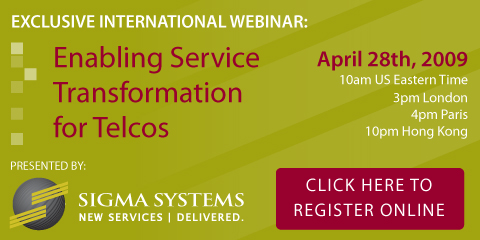
By
Tim Young
There's nothing wrong with a legacy network. It's reliable. There are ways to make it fairly fast and efficient. Most importantly, it's out there already. So, in the strictest sense, there's nothing wrong with it.
Only... there is a great deal more possible from a network, and a great deal more possible from the processes that support it. In an age of increased consumer expectation, a network is needed that's smart, capable, and flexible. A transformed network.
“Underneath all the technical jargon... there is something fundamental changing that will profoundly affect the life of every person and every business on the face of the planet over the next two decades,” said Dr. Hossein Eslambolchi (CEO of Divvio, former AT&T visionary, and harbinger of transformation) in his keynote address at Management World-Americas in November of 2008. “We are right in the middle of the transformations of the legacy systems, processes, networks, and applications into one global, seamless, virtual MPLS-IP-Wireless world.”
The process is arduous, and the umbrella topic of “transformation” consists of a few components that should work in concert: Transformation of the network and transformation of the OSS and BSS underlying that network. The former is well-underway, with working examples in existence already. The latter is a longer and more difficult process.
|
|
“There is something fundamental changing that will profoundly affect the life of every person on the face of the planet.” |
|


network in the 4th quarter of 2008 as well, giving them over a million new subs in 2008 as well.
Similar numbers are being reported by other telcos who've made the leap. More subs. Faster service. What could stop this juggernaut?
Unfortunately, the worldwide economic slowdown threatens to slow down the expansion of some existing next-gen networks, and hamper the creation of new ones by companies who've yet to make the actual leap towards service rollouts.
It's the unstoppable force of transformation and expansion meeting the immovable object of the slow economy, and it's not good for anyone.
|
|
|
|

Up and Running
Several all-IP networks from major telcos are already out there, in the marketplace. (AT&T's U-Verse, BT's 21CN, and Verizon's FiOS are probably the most familiar examples.) This has been no small task. AT&T has called their rollout the largest 40-gigabit OC-768 deployment the world has ever seen, and U-Verse now boasts over a million subs (as of the end of 2008). Verizon announced that it added some 330,000 subs to its FiOS
|
|

AT&T, for example, has announced that it will make cuts in the rollout budget to the tune of $2 Billion, which slows their rollout by 10-15%, causing them to push their U-Verse goal of passing 30 million homes to 2011, a year later than previously stated.
However, there's an even more difficult area of transformation
article page
| 1
| 2
| 3
| |
|






